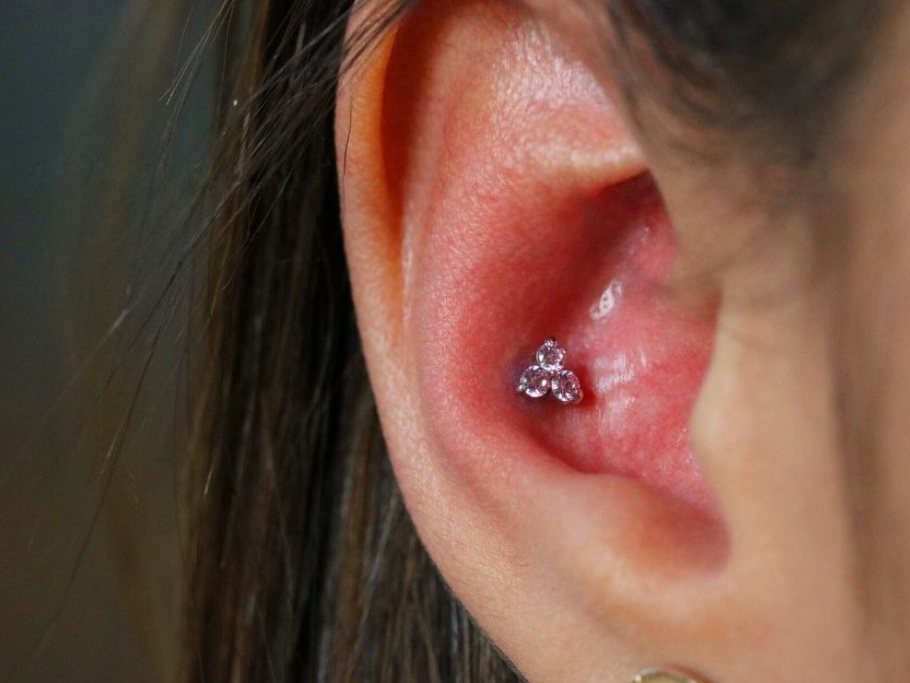You've probably seen a helix piercing around. An earring is a simple method to update your style; it can be a subtle accent or a bold statement, and it sits in the same place, at the top of your ear. The helix piercing is quickly becoming as iconic as the lobe piercing. If you've been thinking about having a helix piercing for a long time to complete your earscape, here is your guide to ear piercing. Perhaps you've never heard of this placement before and are curious about its hype.
We've got your back either way. Learn more about the helix, its anatomy, and whether or not piercing it causes greater discomfort than other areas of the ear. Most important, you'll learn about necessary aftercare from the team at Studs, the millennial's go-to jewelry brand, and piercing studio. Read on for detailed information about helix piercings.
What is A Helix Piercing?
You may have seen people get piercings in slightly different spots throughout the ear and wondered if they were all the helix. The answer is: yes. A lot of people ask, "what is a helix piercing?" According to piercer Shannon Freed of Studs, "a helix piercing is any piercing along the upper and exterior cartilage ridge of the ear." "That part of the ear is called a helix because of its shape in 3D," the author writes.
It's important to note, however, that many points along this curve have been given descriptive names. A forward helix rests on the cartilage closest to your face, whereas a flat helix rests on the flat section of the inner ear. Two piercings close to one another along the helix constitute a snakebite piercing.
Do Helix Piercings Hurt?
Be honest; you know it hurts when your helix gets pierced. Can you say that it hurts more than the lobe? The helix, being less fleshy than the lobes, will hurt more than the lobes, according to Freed. Compared to other types of tissue, cartilage is denser, so puncturing it can be more difficult and painful. Pain is short-lived, but your stunning new piercing will last a lifetime.
Helix Ear Piercing Healing Time
The length of time Freed says, "helix ear piercing healing time is relative and depends on things like your overall health, sleep and stress levels, and your aftercare regimen." People's responses to and recovery from physical stressors will vary. To give you a ballpark figure, though, Freed suggests at least two months. Two to four months is the typical first healing period after getting a helix piercing.
It takes about six to nine months for the piercing to heal completely. How long it takes for an ear piercing to heal depends on the piercing itself and the individual. Still, you can tell it's healed when the ear no longer has any signs of infection or inflammation, such as discharge, swelling, redness, peeling, or discomfort.
 Helix Ear Piercing Healing Time
Helix Ear Piercing Healing Time
How About Taking Care Of Helix Ear Piercings?
Your fresh helix piercing should stop hurting once some time has passed. Maintaining your new earpiece correctly will ensure that it continues to look and feel fantastic for a long time. Freed advises not touching the new piercing for the time being. You shouldn't touch it or twist it, Freed warns. Also, saline should be sprayed twice daily, once on the front and once on the rear.
You should also avoid snagging the piercing and sleeping on it, as both might delay the healing process. Always use saline solution for cleansing. The salt helps draw out extra discharge while boosting blood circulation. You'll want to avoid rubbing alcohol, hydrogen peroxide, and ointments, as they might dry up and further irritate your piercing, increasing the total healing time.
Treatment Of Infected Helix Ear Piercings
Irritation is often misunderstood as an infection by some. Although discomfort is typical, Freed assures us that proper post-operative care should prevent serious infection. Minor bleeding, "crusties" (dead skin cells), swelling, pain, itching, bruising, or soreness are all to be expected. The duration of these symptoms is short, usually less than a month. But Freed advises seeing a doctor if you develop any symptoms beyond this.
What Kind of Jewelry Is Used for a Helix Piercing?
According to experts, stainless steel or titanium are the best metals to utilize because they are inert and should not induce a reaction in the body.
1. Stainless Steel
Stainless steel is a favorite for helix jewelry because it can be fabricated in various attractive forms without compromising quality. However, if you're allergic to nickel, stainless steel isn't for you. Stainless steel works in favour for any sort of cartilage piercing.
2. Gold
Gold is not the finest metal for helix jewelry, but it also isn't a terrible option. Gold is a beautiful choice if you want your piercing to match your other jewelry or for other aesthetic reasons. However, to avoid purchasing jewelry made of soft metal, you should aim for a minimum of 14 karats.
3. Titanium
Titanium is as reliable a material as stainless steel, and it offers even more aesthetic flexibility. Titanium is safe for everyone because it does not contain nickel, whereas stainless steel does.
Conclusion
The anti-helix piercing is placed above the tragus on the inside of the ear. This piercing is rarer. Due to its exposure to more substantial bacteria than a helix piercing, the healing time varies between 6 months and one year. For this type of piercing, you can choose between a simple, a double, or a triple anti-helix, according to your morphology. You can then place several rings there, for example. Helix piercing certainly has no secrets for you. However, do not hesitate to contact our team for any additional information. We are present to find out about your helix piercing or any other piercing in the ear, face, or body.
Frequently Asked Questions
Q1. What kind of jewelry is worn in a helix piercing?
A stud is a little jewelry component with a thin, lengthy backing that is put into a piercing's hold. Mounting a tiny fixture to the back of a stud is the standard method of sealing it in place. A hoop, the same as a ring, is a common jewelry accessory for helix piercings. It's shaped like a ring, but the metal is pliable enough to be bent. If you want to eliminate a hoop, just pull its ends apart.
Q2. How soon can I swim after getting my helix pierced?
Pro piercer Janeese Brooks advises waiting until at least the end of your healing time before going in. Anywhere from three months to a year is the typical healing time for a helix ear piercing. As Brooks puts it, "everything in the water is getting into your piercings," and the chlorine will harm your piercing even in the cleanest of pools. She recommends avoiding the pool at all costs, but if you must get in, promptly clean the region to remove any lingering chemicals.

